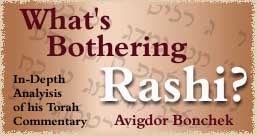

Back to this week's Parsha| Previous Issues
Parashios Tazria-Metzorah
A very brief comment. Understanding it fully makes us aware of an unclearity in the text not usually noticed Leviticus 13:12 "And if a leprosy break out abroad in the skin; and the leprosy covers all the skin of the aflliction from his head unto his feet, wherever the priest looks." From his head: Rashi: of the man unto his feet. What Rashi Saying? Because we are working in English, we must clarify something about these words in Hebrew. The Hebrew word "rosho" can mean either "his head" or "its head." The chumash says "merosho v'ad raglav." Which means either "from his head unto his feet" or "from its head unto its feet." Rashi tells us that the "leprosy covers all the man's skin from his head unto his feet." Another point: The main word in this section is "nega". This can be be translated as "plague" as "affliction" or as "sore." Of course the term "plague" implies that this sore is a divine retribution and not just a naturally caused medical problem. Questioning Rashi Now, back to the comment itself. This is one of those brief (Type II) comments which Rashi inserts within the words of the Torah. These are meant to help us avoid a misunderstanding. Which misunderstanding is Rashi helping us avoid here? Hint: Look closely at the entire verse. Translate it to yourself so that you understand it fully. Your Answer: A Possible Misunderstanding? Some English translations of the Torah [mis]translate our verse as follows: "If the leprosy will erupt on the skin and the leprosy will cover the entire skin of the affliction from his head to his feet, wherever the eyes of the priest can see it." Does this make sense to you? Really? What do these word mean: "leprosy will cover the entire skin of the affliction ..." How can the leprosy cover the affliction? The "affliction" and the "leprosy" are the exact same thing. They both refer to the same area of the skin that is affected/afflicted. If so, how can the leprosy cover any less than the entire skin? The "cover" is the leprosy and the leprosy is the affliction. So then what does this verse mean? Your Answer: Understanding Rashi The Hebrew phrase "v'chisisah hatzara'as ais kal ore hanegah me'rosho v'ad raglav..." is to be translated as follows: "and the leprosy covers all the skin of him who has the affliction from his head to his feet..." The words in italics are to be added. This is to say that the Hebrew word "negah" does not mean "affliction", rather it means "the person with the affliction." If that is the case, then Rashi's comment is precise. He tells us that the words mean "From the head of the man [with the affliction] to his feet." Rashi intends to guard us against the possible misunderstanding that these words might mean "from the head (top) of the affliction to its feet (bottom)." Rather the correct meaning is that this affliction (the leprosy) covers all the skin of the body of the afflicted person. Can you find support for this interpretation which translates "negah" as "the person with the affliction" and not just as "affliction" alone? Hint: Look at other verses in this section. Your Answer: Evidence for this interpretation An Answer: See the very next verse, where we see that all the skin of the person is covered. "Then the priest shall see and behold the leprosy has covered all his flesh; he shall pronounce him clean that has the affliction. It is all turned white, he is clean." Likewise a previous verse 13:4 says "And if the bright spot ...then the priest shall shut up [ he that has] the affliction seven days." Here too the word "negah" must mean the person who has the affliction and not just the affliction itself. The priest doesn't shut up "the affliction," rather he "shuts up the person who has the affliction." A Moral Lesson We see from all this that the Torah equates the affliction ("negah") with the person who has the affliction. This is quite unusual, and the Torah may have done this to teach us something. In this chapter (Leviticus 14:4), Rashi tells us that the plague of leprosy comes upon a person as punishment for his evil slander ("lashon harah"). We also know that Miriam, after she spoke against her brother Moses, was stricken with leprosy (See Numbers 12:). Several explanations have been offered as to why this punishment is meeted out for this crime. Be that as it may, leprosy ("negaim") is the punishment. A person commits "lashon harah" when he points out an actual fault of another person and implies that this one fault indicates that the whole character is blemished because of it. What is called "character assasination." The victim's whole character is attacked. One fault = the whole personality. How fitting, then, that the Torah, in its characteristicaly subtle way, should also equate the "negah" with the preson afflicted with the negah.!
Back to this week's Parsha| Previous Issues
|